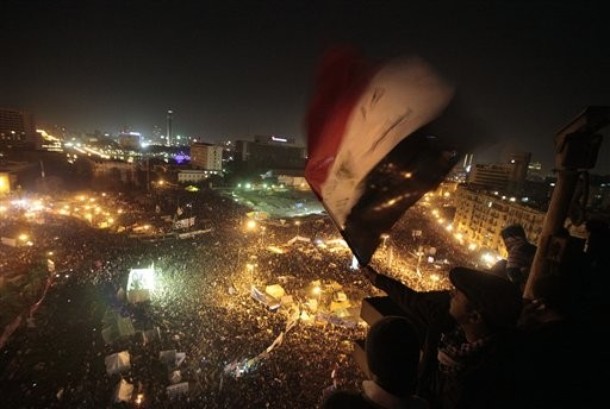
Mara Revkin interviewed EgyptSource contributor Magdy Samaan from Tahrir Square on January 25, amid celebrations and protests commemorating the anniversary of the Egyptian revolution.
Greetings from Cairo on January 25. I have been closely observing the anniversary protests on the ground with my colleague Magdy Samaan, a former visiting fellow at the Atlantic Council’s Rafik Hariri Center, whom I interviewed from Tahrir Square this afternoon, as we navigated a sea of Egyptian flags and flying elbows. In this admittedly amateur and unedited video, Magdy sheds light on today’s demonstrations. While the crowd appears monolithic and united from a distance, the view on the ground reveals a divided and diverse array of interest groups and separate movements, only some of whom are here to celebrate the revolution’s achievements. Others, Magdy explains, remain deeply frustrated with continued military rule and have mobilized to condemn, rather than honor, what they view as the subversion of Egypt’s democratic transition. Please excuse the unsteady footage and interruptions from bystanders:
I arrived in Cairo the night of January 24, just in time to see hundreds of buses stream over the Qasr-El Nil bridge toward Tahrir Square, where tens of thousands of Egyptians gathered overnight to participate in planned celebrations to honor the 1-year anniversary of the January 25 uprising. Traffic was so dense around the square that I had to ask the driver to drop me off at the perimeter. Pushing through the packed crowds, suitcase in tow, I was asked to present my ID at several checkpoints, arranged as human chains in concentric circles around the square. As promised by the Supreme Council of the Armed Forces (SCAF), security personnel were noticeably absent from the square, although nearly fifty ambulances were stationed near the entrances to the square, prepared for peaceful demonstrations to turn sour at any moment.
With light rain falling on the square, the crowds were undeterred by the weather and I passed dozens of Egyptians toting piles of blankets, preparing to camp out overnight and possibly much longer. Activist coalitions including Kefaya, Mohamed ElBaradei’s campaign and the Union of Revolutionary Youth have declared an open-ended sit-in, vowing that they will not leave the square until the revolution’s unfulfilled demands are realized.
When I returned on the morning of January 25 – jet-lag sufficiently suppressed with six cups of NesCafe – the atmosphere was still celebratory and peaceful. One woman reportedly gave birth in the square, while a marriage was officiated on the Muslim Brotherhood’s official platform. Vendors sold flags of all sizes and other nationalistic memorabilia commemorating the revolution. But despite the festive atmosphere, elements of the crowd were clearly there to protest military rule, rather than honor a revolution whose democratic objectives are still very much in jeopardy, in their view.
Isolated pockets of protesters waved banners and slogans outlining a number of unresolved grievances: an immediate transfer of power to civilians, accountability for former regime officials, an end to military trials of civilians, a minimum wage of LE1200 and pay ceiling of LE18,000 for public sector employees, the cleansing and restructuring of the Interior Ministry, and retribution and compensation for the families of victims of the revolution. Other protesters denounced the Islamist Salafis and the Muslim Brotherhood, who now control over 70 percent of the seats in the newly formed People’s Assembly, and demanded constitutional guarantees for a civil state.
Although Egypt’s military leaders have been determined to preserve the celebratory character of this highly symbolic day and preempt the possibility of unrest, signs of continued frustration with the revolution’s unfulfilled objectives and the deteriorating economic situation were on display in Tahrir Square:
- Posters depicting a noose around the necks of Hosni Mubarak and Field Marshal Tantawi
- Racks of radically discounted clothing and shoes for sale on the side streets, where shopkeepers complained of dwindling revenues
- “Down with Military Rule” and other anti-military slogans echoed around the square
- Makeshift field hospitals near Hardee’s fast-food restaurant, adjacent to Mohammed Mahmoud Street – the site of November’s bloody clashes between security forces and protesters – an unsettling reminder of how quickly past demonstrations have devolved into violence.
The SCAF has taken great pains to frame today’s demonstrations as a public celebration of the revolution’s achievements, benefiting from the support of thousands of Muslim Brotherhood volunteers, who seemed to have taken the lead in forming citizen security committees and checkpoints to maintain security around the perimeter of the square (depicted in the video below).
The Muslim Brotherhood’s stage, one of the most prominent, was also a focal point of the festivities, hosting a series of rousing speeches as well as the matrimonial ceremony described above.
With the crowds swelling as the sun sets, it’s unclear what tomorrow will bring, but look for another dispatch from EgyptSource soon. Signing off in Cairo,
Mara
Photo credit: AP Photo
Image: tahriregyptflag.jpg
